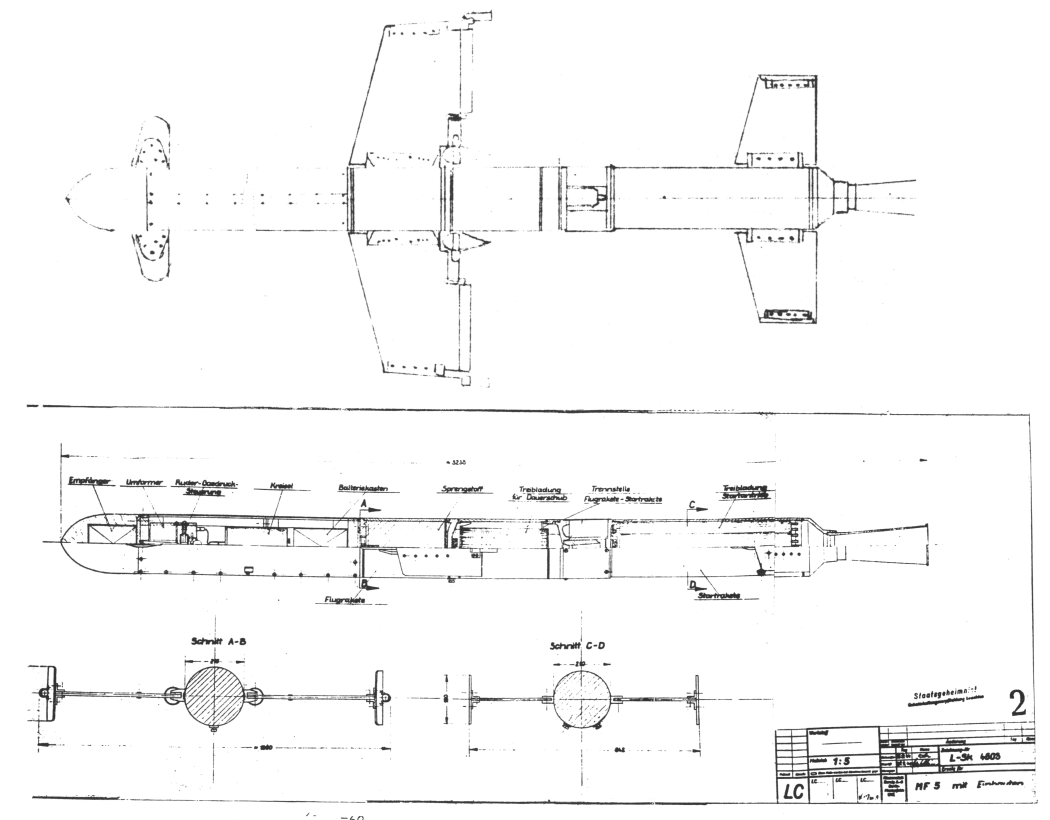One of the lesser known rocket projects from WWII Germany is the MF-5. I’ve found very little about this two-stage missile over the years… a mention in Ordway’s “International Missile and Spacecraft Guide” and a few drawings found buried in the NASM archive more than a decade ago.
According to Ordway, the “Nutcracker” was developed for the German Navy by Rheinmetall-Borsig at Marienfelde-Berlin. It was intended for use against low-flying aircraft. It was the fifth of the “Marine Flak” series; work began on it in July 1944, but was stopped in September. A Telefunken Kogge system was used for radio-remote control… but left unexplained was exactly how the missile was tracked. If it was meant for launch specifically from submarines, then presumably that means it was meant for underwater launch, in which case only a periscope would be available to track both the missile and the target… which seems a dubious prospect.
Length according to the drawing was 3238 mm, span over the main wing, 1290 mm. Other data from Ordway:
Weight: 473 pounds
Warhead: 25 pounds
Velocity: 536 mph
First stage thrust: 1,040 lbs for 0.9 seconds
Second stage thrust: 510 pounds for 10 seconds
5 Responses to “MF-5 “Nussknacker:” Sub-launched SAM”
Sorry, the comment form is closed at this time.

Looks like a total balls up, typical of the brain damaged subhumans of Germany.
You sure this thing is real?
I’ve been studying German secret weapons projects for forty years, and I’ve never heard of this thing before.
Assuming it is a real program, tracking is optical via the wingtip flares.
This implies that the sub has both its periscope and uplink missile guidance antenna out of the water when used, and the non-folding wing and tail means it can’t come out of a torpedo tube, so it’s probably surface launched to intercept enemy sub-hunting aircraft while the sub is recharging its batteries at night.
Since that can be done while submerged via the snorkel, this whole concept doesn’t make a lot of sense – as all it does is make the sub a bigger target for radar-equipped aircraft to detect at night than their snorkel would be, while the attacking aircraft themselves will be hard to see with their navigation lights off, since you will only have the sub’s radar to tell you where they are.
Maybe you are supposed to sight in on them via IR equipment?
It appears to use the bobbin-deployed wires to send guidance commands to it like some versions of the Hs-293 and the X-4 AAM, the bobbins being located at the base of the wings in this design rather than on the wingtips like in the other two missiles.
This raises a major question; the position of the bobbins means that the deploying wires will be caught in the back-blast of the booster exhaust on launch and melt unless they then spread out to the twin tail fins on the booster, but if that’s the case, then how are they to be freed from it when it’s jettisoned, and what’s to keep them from being melted once the cruise engine takes over?
The whole thing smells funny if it really was designed like shown here.
The powerplant was to be the Schmidding 109-573 rocket engine, the same intended to be employed on the “Unterwasserlaufkörper”.
Great find, Scott.
> You sure this thing is real?
Yes. Oldest reference I could find to it is a brief mention in a US Army publication from 1947.
> It appears to use the bobbin-deployed wires
No, it does not. The whole front end is the radio reciever and control unit. The forward-most “box” is the “Empfänger,” or radio reciever. The “bobbins” are most like simply drag-bodies, as used ona number of early missiles.